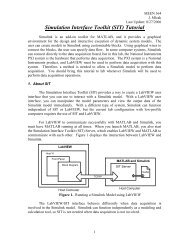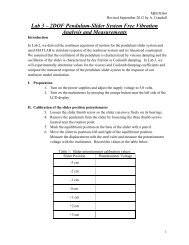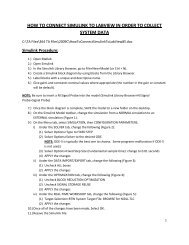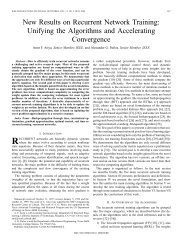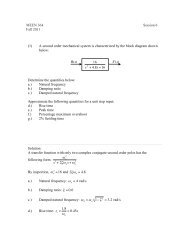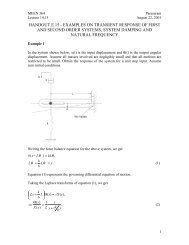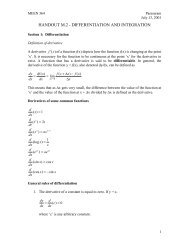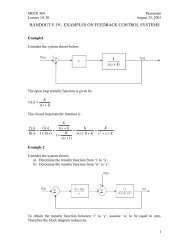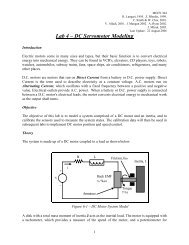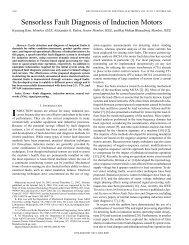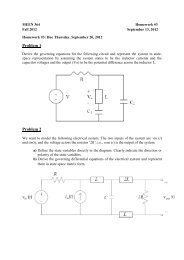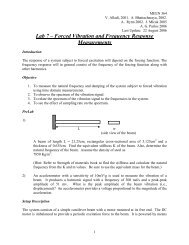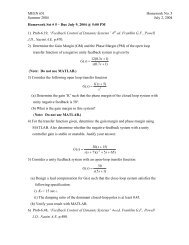MEEN 364 Lab Report Format - Texas A&M University
MEEN 364 Lab Report Format - Texas A&M University
MEEN 364 Lab Report Format - Texas A&M University
Create successful ePaper yourself
Turn your PDF publications into a flip-book with our unique Google optimized e-Paper software.
<strong>MEEN</strong> <strong>364</strong> <strong>Lab</strong> <strong>Report</strong> <strong>Format</strong>Revised by Ahmed Saeed, August 28, 2007The ability to communicate effectively is one of the cornerstones of engineering. For thisreason, you will be graded not only for your technical performance but also on your ability towrite clearly. The format described below will be used throughout the semester. However,certain sections are either not required or are not applicable in certain labs. Your TA will let youknow what you are responsible for on each lab.It is important to realize that while this is a technical course and these are technical reports, itis still necessary to adhere to standard grammar rules. All reports should be written in the pasttense, third person. Do not use words such as, “I”, “we”, or “our.” This is critical in technicalreports. Also, remember to follow basic rules such as indenting at the start of a new paragraph.Because they are technical documents, lab reports should appear in a standard format. Forthis lab, all reports should be typed, using the Times New Roman font, size 12. Use a 1.5 linespacing, 1-inch margins all around, and the left and right justify alignment. All pages should benumbered, with the exception of the cover sheet. A standard cover sheet with the lab number,title, section number, date, group members’ names and signatures should be used. This is shownin Appendix A as Figure A.1. The following format should be used for the lab reports:I. Executive Summary (Abstract)This section is a short, stand-alone description of the entire lab report. It shouldinclude what experiment was performed, why it was performed, the procedure thattook place, the results that were gained, and what these results mean. However, theexecutive summary should not cover these subjects too in depth. A few lines on eachof these questions are adequate. The executive summary should be able to standalone from the rest of the report. It goes on a separate page as the rest of the report,and should be no longer than this one page.1
II.IntroductionThis section outlines what the lab is about. Try to be specific in terms of what themain objective(s) of the lab have been and what tasks have been accomplished toachieve these objectives. It is okay to use the lab manual as a reference for this andsubsequent sections, but be careful to use your own thoughts and cite your referencesas to avoid plagiarism.III. TheoryThe theory section gives the reader the background information for theexperiment. This is much like the theory section in the lab manual (read again thewarning above about plagiarism). This section should include the description of whatwill occur in the experiment according to theory as well as any laws or formulas thatwill be used in the interpreting the results.IV. ProcedureFor each task or exercise performed in the lab describe what was done, how it wasdone, and state your results. Details and organization are important and figures andtables must be labeled and properly referred to. It is convenient to think of thissection as what was performed during the lab period, as opposed to the theory, whichis what was necessary in order to start the lab, and the results, which is what is doneafter the lab period is over.V. ResultsFor a lab report, the results section includes more than just the data that wasobtained during the experiment. Here, it is necessary to convert the acquired data intoan understandable format and interpret what these results mean. This also shouldinclude how the data was interpreted. It is not enough to just state an answer; youmust also state how you came to this answer, whether this is a good answer or not,2
and what this answer means. It is important here to explore and explain any sourcesof error in the experiment or in the calculations. Also, be sure to answer anyquestions posed in the lab manual.VI. Conclusion / SummaryThis section in a sense repeats the Introduction section of the report but in briefform and emphasizes the key concepts that you learned in the process of performingthe lab. However, it is unlike the introduction in that you should repeat the endconclusions that you obtained in the result section. No new information should bepresented in this section.VII. BibliographyIt is important to cite any sources that were used in your lab report. This shouldalways include the lab manual, as you will use it for every lab report. This shouldalso include any textbooks or websites that you referred to for your lab report. Forexample, the lab manual could be listed as follows:Gilman, Justin, and Glasofer, Joseph. “Introduction into <strong>Lab</strong>VIEW Programming,<strong>MEEN</strong> 260 <strong>Lab</strong>oratory Manual.” <strong>Texas</strong> A&M <strong>University</strong>, 2003.VIII. AppendixSupporting information that can be separate from the main write up should beplaced here. In general, this section should include detailed information that whileimportant does not directly contribute to the main flow of the report. For most of thelabs in this course, this section will be minimal. This section is mostly for repetitiveinformation. For example, some labs require you to perform the same operations on3
several sets of data. It is appropriate to detail and show the calculations for one set ofdata along with any resulting graphs within the context of the report (in the resultssection). In this case, the calculations for the other sets of data that mirror thecalculations described in the report could be included in an appendix. Be careful notto put data that is necessary to the data interpretation in the appendix. This onlyserves to interrupt the flow of the report by making the reader flip back and forthbetween sections. When using an appendix, the first sheet should have a title such as“Appendix A,” with a listing of the information contained in the appendix.It is important to remember that the point of writing a lab report is so that someone elsecan understand what you did and why you did it. Therefore, it is important to be clear in yourexplanations. Do not write these reports with the TA in mind. The lab reports should be writtenas though the reader had only a cursory knowledge of math, science, and engineering.One of the best ways to explain technical information is by using equations, tables, andfigures. These are necessary means of communicating your ideas. There is a standard format foreach of these as well.Equations should be entered in using standard math symbols and syntax. The best way todo this is to use Microsoft Equation Editor, which is included in Microsoft Word. Equationsshould appear on a separate line as text.They should be centered on that line with acorresponding equation number aligned to the right. It is important to number all your equations,tables, and figures so that they can be referred to within the text of your report. Likewise, it isimportant to refer to a particular equation, table, or figure you are speaking of by number as toavoid confusion. Through out this section, the example of obtaining the slope of several sets ofdata will be used in order to demonstrate the correct way of using equations, tables, and figures.Equation (1) demonstrates how to find the slope, m, of two sets of points as follows,where (x 1 , y 1 ) and (x 2 , y 2 ) are the two sets of points.myx1 2= , (1)1−−yx24
A table is any set of corresponding data put into categories. They need to boxed intocolumns and rows. Be sure to be reasonable in using tables. A table that only consists of 2 setsof 2 data points may be better explained in text. In addition to being numbered, tables must alsobe given a title, which is placed at the top of a table. It is very important that this be a fullydescriptive title. Tables should be numbered as Table 1, Table 2, or as Table 1.1, Table 1.2, andso on. The second way of numbering tables (as well as figures) is for reports that contain manydifferent experiments. Since the reports in this course do not, either way is appropriate as longas you are consistent. Table 1 below shows three sets of data points which define three differentlines.Table 1: Three sets of data points that define three different lines.(x 1 , y 1 ) [units] (x 2 , y 2 ) [units] slopeData Set A (10, 3) (2, 6) -0.375Data Set B (10, 4) (5, 7) -0.600Data Set C (10, 2) (1, 3) -0.111It is important to note here that while this is a simple example without any units, it isnecessary to include the units of any measurements in the column or row heading. Also becareful to not split a table or figure between two pages. It is not critical that a table or figure isdirectly before or after the corresponding text, just close to it, so it is okay to move a tableforward or back for spacing purposes. If a table is too long for one page, it is too big and wouldbe better represented by a figure.A figure is anything that is not a table or equation. This includes graphs, pictures,screenshots, and so on. Figures are formatted the same as a table only with the title below thefigure instead of above it. Graphs are very important in technical writing because they canconvey a lot of information in a little space. It is important that these be clear. Below is Figure 1to illustrate this.Graphs must be clear and concise. To do this, make the graph the focus of your figure,not the corresponding words. Make sure all labels are the same font size. For graphs with5
Y (units)8765432100 2 4 6 8 10 12X (units)Data Set A Data Set B Data Set CFigure 1: Three lines represented by data sets A, B, and C.multiple data sets, include a clear legend that corresponds to the text and is placed below thegraph. Here, the lines could be labeled x, y, and z, but that does not correspond to the tableabove where the same data sets are labeled A, B, and C. Make sure to label the axis, includingthe units. Again, provide a descriptive title for your figure.You may have a color printer, but color is not required for your lab reports and low inklevels or unexpected problems could lead to confusion in your data presentation. Therefore, it isnecessary to differentiate separate data sets using different line styles or different markers. Besure that this is clear so that the reader can determine which data set corresponds to which label.It is sometimes also helpful to refer to this in the text. An example of this is to say, “Data Set B,represented by the circle markers in Figure 1, has a negative slope much greater in magnitudethan Data Set C, shown with the square markers.” Other ways of assuring clarity is to not use abackground color in the graph and to adjust the axis so that the area in question is shown clearlywithout the different data sets appearing on top of one another.6



